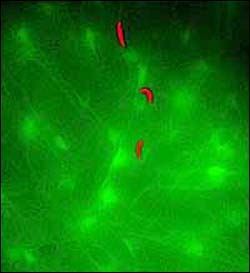Tracking a killer: Observing liver invasion by malarial parasites

Tagged with red fluorescent protein, the malarial parasites in the sporozoite stage can be seen migrating along the sinusoids in a mouse liver. (Photo: Ute Frevert et al.)
Despite the efforts of governments and the World Health Organization to combine prevention measures and efforts to eradicate malaria-carrying mosquitoes, the disease kills more than a million people each year. Much is known about the microbes that cause the disease, tiny parasites of the genus Plasmodium, which have a complex life cycle involving several distinct phases and habitats. But, many details of the organism’s life cycle, including a critical stage in the parasite’s life cycle – invasion of the liver – have escaped direct observation until now. In their new study published in the open-access journal PLoS Biology, Ute Frevert et al. used intravital microscopy – which allows direct observation of events in a living animal – to study the discrete steps that facilitate the parasites’ entry into the liver.
To make these observations, the authors introduced genetically engineered Plasmodium parasites that express fluorescent tags to rodents through mosquito bites, and then watched for the arrival of the parasites in the livers of the test animals. They observed parasites crawling along the interior of the liver sinusoids (which take the place of capillaries in the liver), sometimes against the direction of blood flow, until they reached their portal of entry – a specialized cell called a Kupffer cell. They then watched as sporozoites traversed Kupffer cells using a special process distinct from ordinary parasite locomotion.
Upon exiting the Kupffer cell on the other side, the sporozoites wreaked havoc in the liver, leaving a path of destruction and dead cells behind them. They moved through several consecutive hepatocytes before finally settling down in one to begin reproducing. The visualization advantages provided by using the fluorescent parasites and intravital microscopy now make it possible to directly observe events in the Plasmodium life cycle that had only been inferred before. Understanding the invasion will help researchers in the battle against this deadly disease organism.
Media Contact
All latest news from the category: Life Sciences and Chemistry
Articles and reports from the Life Sciences and chemistry area deal with applied and basic research into modern biology, chemistry and human medicine.
Valuable information can be found on a range of life sciences fields including bacteriology, biochemistry, bionics, bioinformatics, biophysics, biotechnology, genetics, geobotany, human biology, marine biology, microbiology, molecular biology, cellular biology, zoology, bioinorganic chemistry, microchemistry and environmental chemistry.
Newest articles

High-energy-density aqueous battery based on halogen multi-electron transfer
Traditional non-aqueous lithium-ion batteries have a high energy density, but their safety is compromised due to the flammable organic electrolytes they utilize. Aqueous batteries use water as the solvent for…

First-ever combined heart pump and pig kidney transplant
…gives new hope to patient with terminal illness. Surgeons at NYU Langone Health performed the first-ever combined mechanical heart pump and gene-edited pig kidney transplant surgery in a 54-year-old woman…

Biophysics: Testing how well biomarkers work
LMU researchers have developed a method to determine how reliably target proteins can be labeled using super-resolution fluorescence microscopy. Modern microscopy techniques make it possible to examine the inner workings…





















